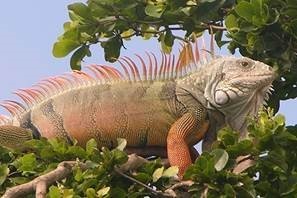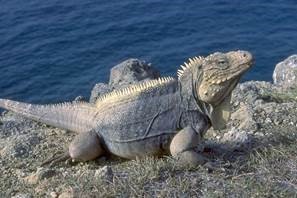Collaborative post by Charles Knapp, Vice President of Conservation Research, John G. Shedd Aquarium; Stesha Pasachnik, Conservation Research Postdoctoral Associate, San Diego Zoo Global; Tandora Grant, Senior Research Coordinator, San Diego Zoo Global; John Iverson, Biology Research Professor, Earlham College; and Allison Alberts, Chief Conservation and Research Officer, San Diego Zoo Global
This week the online journal Herpetological Conservation and Biology published a compilation of research papers titled Iguanas: Biology, Systematics, and Conservation. The compilation highlights the diversity and unique ecology of iguanas, while emphasizing the threats to their survival and need for conservation action. Though the Green Iguana, most commonly seen in pet stores, often comes to mind when people think of these lizards, researchers have described 44 unique species of iguanas, with more on the way. Iguanas are found throughout the New World including Central and South America, the islands of the West Indies, and within the Galápagos Archipelago. However, some species can even be found in Fiji and the Tonga Islands. With so many species and so many unique environments, the diversity of sizes, colors, and behaviors among iguanas is impressive. Iguanas live in trees and on the ground. Some climb volcanoes to lay their eggs in the warm soil within calderas, while others dig nests in termite mounds and guard them for months! Some swim in the ocean and munch on algae, others restrict their diet to mangrove leaves; however, most feed on leaves, fruits and flowers of terrestrial trees and shrubs. Regardless of where they live, iguanas serve a vital ecological role because of their herbivorous feeding strategy, which is relatively unique among lizards. By eating leaves and fruits, iguanas promote foliage growth, provide nutrients for seedlings, and disperse seeds to new areas.
Although iguanas are vital to many ecosystems, they face serious threats. Deforestation and other human-caused disturbances such as predation and competition from non-native species, hunting, smuggling for the illicit wildlife trade, and unregulated tourism, have brought many species near extinction. In fact, while we celebrate the recognition of 44 species, we also mourn the fact that 82% of the 34 species that have been listed on the International Union for Conservation of Nature (IUCN) Red List of Threatened Species are threatened with extinction. Consequently, these distinctive lizards are among the most threatened vertebrate groups on the planet, surpassing turtles (50-58%), primates (ca. 49%), and amphibians (ca. 41%).
There is hope. The iguana conservation and research community has grown over the last two decades. A major factor in bringing together this community has been the IUCN Species Survival Commission (SSC) Iguana Specialist Group (ISG). The ISG was formed in 1997 and has since expanded to 93 members in 24 countries, including representation from all regions in which iguanas occur naturally. The group has worked with local government agencies and NGOs to draft 14 Species Recovery and Conservation Management Plans that outline the most urgent research needs and conservation actions for individual taxa, many of which are reflected in Iguanas: Biology, Systematics, and Conservation. Not surprisingly, 29 of the 69 authors (42%) contributing to this collection are ISG members.
Conservation action requires that local stakeholders take ownership of initiatives aimed at studying the unique ecology of individual iguana species, and implementing tailored mitigation strategies that work best when socioeconomic and political considerations are addressed. Encouragingly, scientists from countries where iguanas occur contributed significantly to the compilation. Moreover, 42% percent of the authors contributing to the compilation represent eight countries outside of the United States and Europe. This is a dramatic increase from the past two iguana compilations, published in 1982 and 2004, demonstrating the expansion of the global iguana community.
Everyone can play a role in iguana conservation regardless of where you live, or if you have a scientific background. The IUCN SSC Iguana Specialist Group is always open to new collaborators, and we enthusiastically welcome those who have a contributing skillset to join us. Likewise, people can contribute to the International Iguana Foundation, which supports conservation, awareness, and scientific programs that enhance the survival of wild iguanas and their habitats. For pet enthusiasts interested in iguanas, it's important to understand the damage done to many threatened iguana species as a result of illegal or unregulated trade. Listing a species as captive bred is a loophole that traders sometimes use to sell illegally exported animals. Further even if iguanas are captive bred, it does not mean that the original breeding pairs were exported legally from their country of origin. Consider conducting research on the legality and ethics of commercially traded animals, as well as their status in the wild, when purchasing a rare species. One place to start is EcoHealthyPets. Your small collective actions can make a big difference for protecting endangered iguanas.




